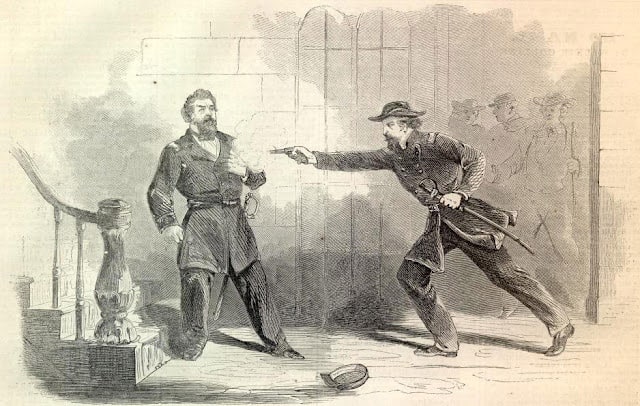
Brig. Gen. Jefferson C. Davis shoots Maj. Gen. William Nelson. (archivesofamericanhistory.typepad.com)
September 21, 1862 – October 4, 1862
By Phil Kohn
Phil Kohn can be reached at USCW160@yahoo.com.
On September 21, 1862, Gen. Braxton Bragg’s Confederate troops moving north from Munfordville, Kentucky, arrive at and occupy Bardstown, in central Kentucky. His purpose is to allow his men to join with those of Maj. Gen. E. Kirby Smith, although neither general seems in a hurry to link up with the other. In the meantime, to the west, some 56,000 Union troops of the Army of the Ohio, under Maj. Gen. Don Carlos Buell, parallel Bragg’s movements and occupy Louisville, Kentucky, about 40 miles to the northwest of Bardstown.
Feeling that the Battle of Antietam was enough of a Union victory for him to act, President Lincoln on September 22 announces his Preliminary Emancipation Proclamation. Under its terms, to take effect on January 1, 1863, slaves are to be freed in territory still under rebel control. The proclamation will free no slaves owned in Northern or Border states, as Lincoln, under the U.S. Constitution, has no authority to do so. (The only slave-holding Northern State is New Jersey; slaves are held in the Border States of Delaware, Maryland, Kentucky and Missouri.)
Maj. Gen. William T. Sherman on September 23 orders the Mississippi River port town of Randolph, Tennessee, to be burned in retaliation for Confederate attacks on Union shipping on the Mississippi.
Confederate Gen. Pierre G.T. Beauregard on September 24 returns to Charleston, South Carolina, where he ordered the firing on Ft. Sumter in April 1861. He takes over as commander of the defenses there, replacing Maj. Gen. John Pemberton. In Washington, D.C., President Lincoln suspends the writ of habeas corpus for any individuals guilty of “discouraging volunteer enlistments, resisting military drafts, any disloyal practice or affording comfort to Rebels.”
On September 27, the Confederate Congress authorizes President Jefferson Davis to call up men aged between 35 and 45 for military service. On the same day, in New Orleans, the first regiment of free blacks is mustered into the U.S. Army (as the 1st Louisiana Native Guards), as authorized by Maj. Gen. Benjamin Butler in August. About 10% of the regiment are former members of a Confederate militia unit also called the 1st Louisiana Native Guards, established in May 1861 and comprising mostly free French Créoles of color. The Confederate unit disbanded on 25 April 1862.
Trouble arises in Maj. Gen. Don Carlos Buell’s Federal Army of the Ohio on September 29, when Brig. Gen. Jefferson C. Davis (often referred to as “the other Davis”) — after a series of bitter conflicts with his superior, Maj. Gen. William “Bull” Nelson, while arranging defenses around Louisville, Kentucky — shoots Nelson during yet another argument, killing him. Because of concerns over the proximity of the Confederate forces of Bragg and Kirby Smith, and possible impending battle action, officers cannot be spared to form a court martial, and Davis is never charged with the crime. (Davis goes on to command a division and then a corps, remaining in the army until his death in 1879.)
On September 30, a brigade of around 4,500 Union troops led by Prussian-born Brig. Gen. Frederick Salomon attacks a Confederate encampment near Newtonia, Missouri. The camp houses a brigade of Col. Joseph O. “Jo” Shelby’s cavalry known as the Missouri Iron Brigade and a mixed force of Indian cavalry and militia under Col. Douglas Cooper. After an all-day fight, the 5,500-strong Confederate troops repulse the Union attack. The Confederates suffer 78 casualties, while Federal casualties number between 250 and 450, depending on the source.
On October 1, Maj. Gen. Don Carlos Buell moves his 75,000 Federal troops out of Louisville, Kentucky, to confront the 40,000 scattered Confederates of Gen. Braxton Bragg and Maj. Gen. Edmund Kirby Smith. There is confusion among the Confederates as to where Buell is heading, as the Federal commander splits his force, sending them in several directions. In Florida, near Jacksonville, Union troops and gunboats engage Confederates at St. John’s Bluff. After three days of fighting, the Confederates withdraw. In Washington, D.C., command over the Federal western gunboat flotilla is transferred from the War Department to the Navy Department. Cdr. David Dixon Porter is named to head the new Mississippi Squadron.
In the Atlantic Ocean, the Confederate raider CSS Alabama on October 3 captures three U.S.-flagged ships as prizes. Meanwhile, some 22,000 Southern troops under generals Earl Van Dorn and Sterling Price attack 23,000 Federal soldiers under Maj. Gen. William Rosecrans at Corinth, Mississippi. The intense fighting carries into the next day. The results are inconclusive, but the battle costs the Confederates dearly in casualties. In southeastern Virginia, a Federal attack on Franklin is repulsed. In Florida, Union troops occupy Jacksonville.
At Newtonia, in southwestern Missouri, U.S. forces, defeated there on September 30, return on Oct. 4 and attack, forcing a Confederate retreat into Arkansas.



